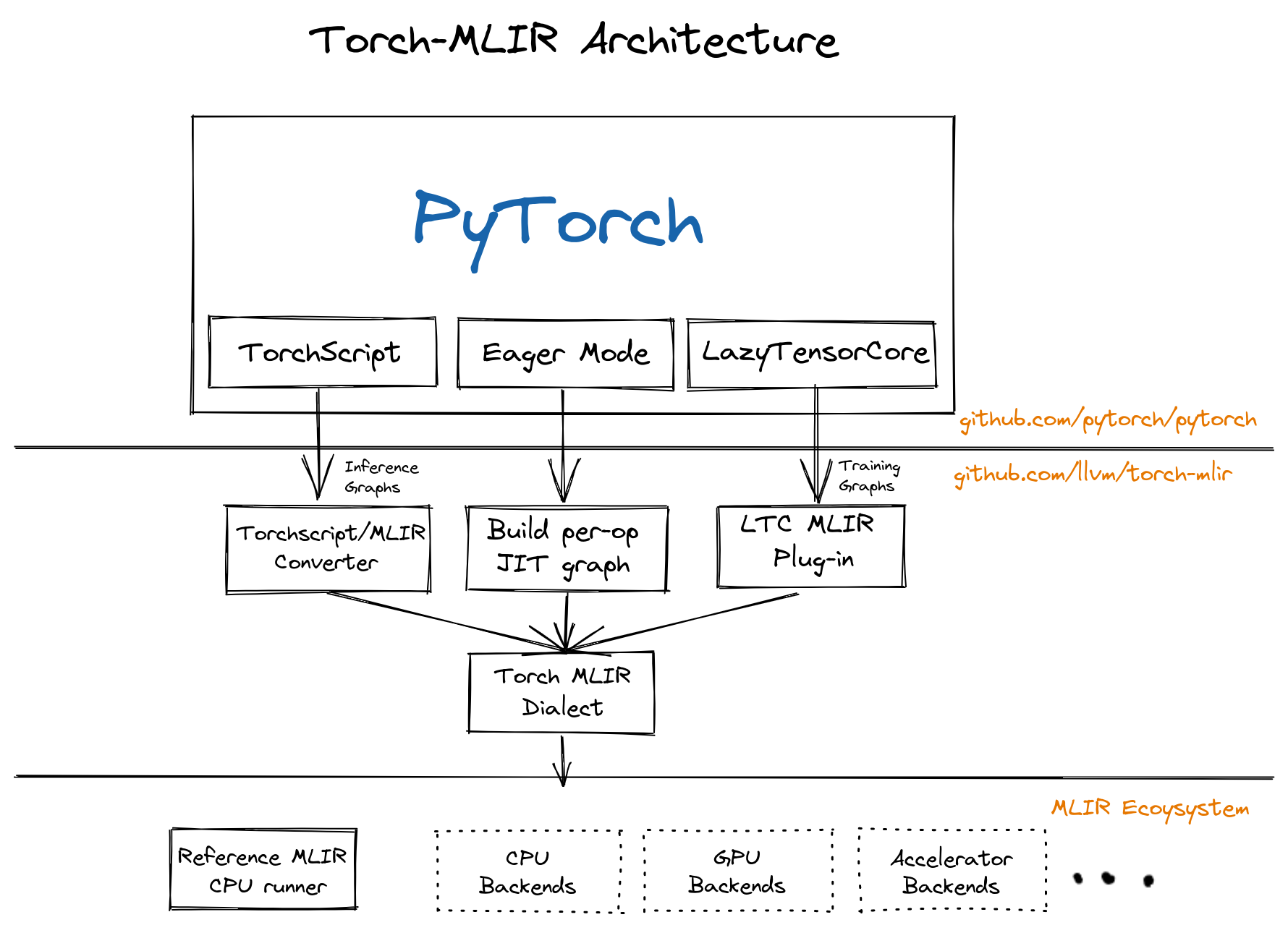|
|
||
|---|---|---|
| .github/workflows | ||
| build_tools | ||
| docs | ||
| e2e_testing/torchscript | ||
| examples | ||
| externals | ||
| include | ||
| lib | ||
| python | ||
| test | ||
| tools | ||
| .clang-format | ||
| .gitignore | ||
| .gitmodules | ||
| .style.yapf | ||
| CMakeLists.txt | ||
| LICENSE | ||
| README.md | ||
| Torch-MLIR.png | ||
| requirements.txt | ||
| setup.py | ||
README.md
The Torch-MLIR Project
The Torch-MLIR project aims to provide first class compiler support from the PyTorch ecosystem to the MLIR ecosystem.
This project is participating in the LLVM Incubator process: as such, it is not part of any official LLVM release. While incubation status is not necessarily a reflection of the completeness or stability of the code, it does indicate that the project is not yet endorsed as a component of LLVM.
PyTorch An open source machine learning framework that accelerates the path from research prototyping to production deployment.
MLIR The MLIR project is a novel approach to building reusable and extensible compiler infrastructure. MLIR aims to address software fragmentation, improve compilation for heterogeneous hardware, significantly reduce the cost of building domain specific compilers, and aid in connecting existing compilers together.
Torch-MLIR Multiple Vendors use MLIR as the middle layer, mapping from platform frameworks like PyTorch, JAX, and TensorFlow into MLIR and then progressively lowering down to their target hardware. We have seen half a dozen custom lowerings from PyTorch to MLIR. Having canonical lowerings from the PyTorch ecosystem to the MLIR ecosystem would provide much needed relief to hardware vendors to focus on their unique value rather than implementing yet another PyTorch frontend for MLIR. The goal is to be similar to current hardware vendors adding LLVM target support instead of each one also implementing Clang / a C++ frontend.
All the roads from PyTorch to Torch MLIR Dialect
We have few paths to lower down to the Torch MLIR Dialect.
- TorchScript This is the most tested path down to Torch MLIR Dialect, and the PyTorch ecosystem is converging on using TorchScript IR as a lingua franca.
- LazyTensorCore (Based on the PyTorch
lazy_tensor_stagingbranch) This path provides the upcoming LTC path of capture. It is based of an unstable devel branch but is the closest way for you to adapt any existingtorch/xladerivatives.
Project Communication
#torch-mlirchannel on the LLVM Discord - this is the most active communication channel- Github issues here
torch-mlirsection of LLVM Discourse
Check out the code
git clone https://github.com/llvm/torch-mlir
cd torch-mlir
git submodule update --init
Setup your Python VirtualEnvironment and Dependencies
python -m venv mlir_venv
source mlir_venv/bin/activate
# Some older pip installs may not be able to handle the recent PyTorch deps
python -m pip install --upgrade pip
# Install latest PyTorch nightlies and build requirements.
python -m pip install -r requirements.txt
Build
cmake -GNinja -Bbuild \
-DCMAKE_C_COMPILER=clang \
-DCMAKE_CXX_COMPILER=clang++ \
-DPython3_FIND_VIRTUALENV=ONLY \
-DLLVM_ENABLE_PROJECTS=mlir \
-DLLVM_EXTERNAL_PROJECTS="torch-mlir;torch-mlir-dialects" \
-DLLVM_EXTERNAL_TORCH_MLIR_SOURCE_DIR=`pwd` \
-DLLVM_EXTERNAL_TORCH_MLIR_DIALECTS_SOURCE_DIR=`pwd`/externals/llvm-external-projects/torch-mlir-dialects \
-DMLIR_ENABLE_BINDINGS_PYTHON=ON \
-DLLVM_TARGETS_TO_BUILD=host \
externals/llvm-project/llvm
# Additional quality of life CMake flags:
# Enable ccache:
# -DCMAKE_C_COMPILER_LAUNCHER=ccache -DCMAKE_CXX_COMPILER_LAUNCHER=ccache
# Enable LLD (links in seconds compared to minutes)
# -DCMAKE_EXE_LINKER_FLAGS_INIT="-fuse-ld=lld" -DCMAKE_MODULE_LINKER_FLAGS_INIT="-fuse-ld=lld" -DCMAKE_SHARED_LINKER_FLAGS_INIT="-fuse-ld=lld"
# Use --ld-path= instead of -fuse-ld=lld for clang > 13
# Build just torch-mlir (not all of LLVM)
cmake --build build --target tools/torch-mlir/all
# Run unit tests.
cmake --build build --target check-torch-mlir
# Build everything (including LLVM)
cmake --build build
Demos
Setup Python Environment
export PYTHONPATH=`pwd`/build/tools/torch-mlir/python_packages/torch_mlir:`pwd`/examples
TorchScript
Running execution (end-to-end) tests:
# Run E2E TorchScript tests. These compile and run the TorchScript program
# through torch-mlir with a simplified MLIR CPU backend we call RefBackend
python -m e2e_testing.torchscript.main --filter Conv2d --verbose
Example IR for a simple 1 layer MLP to show the compilation steps from TorchScript.
Standalone script to Convert a PyTorch ResNet18 model to MLIR and run it on the CPU Backend:
# The example uses PIL and requests to get the image.
pip install requests pillow
# Run ResNet18 as a standalone script.
python examples/torchscript_resnet18_e2e.py
load image from https://upload.wikimedia.org/wikipedia/commons/2/26/YellowLabradorLooking_new.jpg
Downloading: "https://download.pytorch.org/models/resnet18-f37072fd.pth" to /home/mlir/.cache/torch/hub/checkpoints/resnet18-f37072fd.pth
100.0%
PyTorch prediction
[('Labrador retriever', 70.66319274902344), ('golden retriever', 4.956596374511719), ('Chesapeake Bay retriever', 4.195662975311279)]
torch-mlir prediction
[('Labrador retriever', 70.66320037841797), ('golden retriever', 4.956601619720459), ('Chesapeake Bay retriever', 4.195651531219482)]
Jupyter notebook:
python -m ipykernel install --user --name=torch-mlir --env PYTHONPATH "$PYTHONPATH"
# Open in jupyter, and then navigate to
# `examples/resnet_inference.ipynb` and use the `torch-mlir` kernel to run.
jupyter notebook
LazyTensorCore
The LazyTensorCore integration is still in progress, and is being built on the
torch_mlir_ltc_backend branch.
Repository Layout
The project follows the conventions of typical MLIR-based projects:
include/torch-mlir,libstructure for C++ MLIR compiler dialects/passes.testfor holding test code.toolsfortorch-mlir-optand such.pythontop level directory for Python code
Interactive Use
The build_tools/write_env_file.sh script will output a .env
file in the workspace folder with the correct PYTHONPATH set. This allows
tools like VSCode to work by default for debugging. This file can also be
manually source'd in a shell.
Build Python Packages
We have preliminary support for building Python packages. This can be done with the following commands:
python -m pip install --upgrade pip
python -m pip install -r requirements.txt
CMAKE_GENERATOR=Ninja python setup.py bdist_wheel
